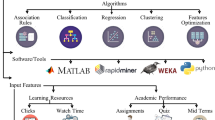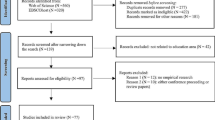Abstract
The purpose of this study was to classify higher education institutions according to institutional performance rather than predetermined benchmarks. Institutional performance was defined as research performance and classified using Hierarchical Cluster Analysis, a statistical method that classifies objects according to specified classification factors. In the analysis, 47 Korean universities with doctoral programs were classified as research universities (seven universities), research active universities (14 universities), and doctoral universities (26 universities). In the detailed discussions, profiles of each group were analyzed and discussed; and, disciplinary classifications were conducted in engineering, natural science, and social science and humanities. In addition, to validate the classifications, the research performances of these categories were compared with those of U.S. peers. In the comparisons, the research performance of Korean universities was similar to that of U.S. peers. From the analysis, the classification results emerging from the performance-based approach were shown to be equivalent to that of conventional classifications using predetermined benchmarks.


Similar content being viewed by others
Notes
The name of the ministry was changed from Korean Ministry of Education & Human Resource Development to Ministry of Education, Science and Technology in March 2008.
These four types of HEIs are often discussed in academic research though there are other types of HEIs such as online institutions (15 institutions), technical institution (one institution), and others (four institutions) in Korea.
The Carnegie Classification also classifies the institutions that award at least 20 doctoral degrees per year as the “doctoral granting university.”
Twenty-one universities that awarded more than 20 Ph.D.s per year (the average number of Ph.D.s awarding between 2003 and 2005) were excluded because these universities published less than 100 articles per year between 2003 and 2005 in international journals (SCI, SCIE, SSCI, and AHCI journals). These 21 universities are Sangmyung University, Incheon University, Sangji University, Chongju University, Sungshin Women’s University, Mokpo National University, Suwon University, Kosin University, Seoul Women’s University, Hannam University, Kyungsung University, Dongshin University, Hoseo University, Korea Maritime University, Korea National University of Education, Daegu University, Kyungnam University, Daejeon University, Hankuk University of Foreign Studies, Kyungwon University, and Kyonggi University. In addition, Information and Communications University (ICU) and Kwangju Institute of Science and Technology were not included in the analysis because there was no data on the number of Ph.D.s awarded on both universities at the KMOE & HRD website.
In counting the number of publications of each institution, the number is a little bit different depending on the method of counting. For details on the counting method, see other articles such as Toutkoushian et al. (2003).
References
Altbach, P. G. (2007). Empires of knowledge and development. In P. G. Altbach & J. Balán (Eds.), World class worldwide: Transforming research universities in Asia and Latin America (pp. 1–28). MD: Johns Hopkins University Press.
Amano, I., & Chen, W. Y. (2004). Classification of higher education institutions in Japan. Fudan Education Forum, 2(5), 5–8. (in Chinese).
Association of East Asian Research Universities. (2008). Member universities. Retrieved Feb. 17, 2008, from http://aearu.ustc.edu.cn/en/.
Becher, T. (1989). Academic tribes and territories: Intellectual enquiry and the cultures of disciplines. Stony Stratford, England: Open University Press.
Biglan, A. (1973). The characteristics of subject matter in different academic areas. The Journal of Applied Psychology, 57(3), 195–203. doi:10.1037/h0034701.
Bland, C. J., Center, B. A., Finstad, D. A., Risbey, K. R., & Staples, J. (2006). The impact of appointment type on the productivity and commitment of full-time faculty in research and doctoral institutions. The Journal of Higher Education, 77(1), 89–123. doi:10.1353/jhe.2006.0002.
Boyer, E. L. (1990). Scholarship reconsidered: Priorities of the professoriate. San Francisco: Jossey-Bass.
Brender, A. (2004). Asia’s new high-tech tiger: South Korea’s ambitious, and expensive effort to bolster university research is paying off. The Chronicle of Higher Education, 50(46), A34.
Burke, K., Duncan, K., Krall, L., & Spencer, D. (2005). Gender differences in faculty pay and faculty salary compression. The Social Science Journal, 42, 165–181. doi:10.1016/j.soscij.2005.03.006.
Carnegie Foundation for the Advancement of Teaching. (2008). Basic classification description. Retrieved Feb. 17, 2008, from http://www.carnegiefoundation.org/classifications/index.asp?key=791.
Feldman, K. A., Ethington, C. A., & Smart, J. C. (2001). A further investigation of major field and person-environment fit. Journal of Higher Education, 72(6), 670–698.
Gladieux, L. E., King, J. E., & Corrigan, M. E. (2004). The federal government and higher education. In P. G. Altbach, R. O. Berdahl, & P. J. Gumport (Eds.), American higher education in the twenty-first century: Social, political, and economic challenges (2nd ed.). MD: Johns Hopkins University Press.
Glassick, C. E., Huber, M. T., & Maeroff, G. I. (1997). Scholarship assessed: Evaluation of the professoriate. San Fransisco: Jassey-Bass.
Hanley, P. F., & Forkenbrock, D. J. (2006). Making fair and predictable salary adjustments for faculty of public research universities. Research in Higher Education, 47(1), 111–127. doi:10.1007/s11162-005-8154-5.
Hekelman, F. P., Zyzanski, S. J., & Flocke, S. A. (1995). Successful and less-successful research performance of junior faculty. Research in Higher Education, 36(2), 235–255. doi:10.1007/BF02207790.
Henderson, B. B., & Buchanan, H. E. (2007). The scholarship of teaching and learning: A special niche for faculty at comprehensive universities? Research in Higher Education, 48(5), 523–543.
Hermanowicz, J. C. (2005). Classifying universities and their departments: A social world perspective. The Journal of Higher Education, 76(1), 26–55. doi:10.1353/jhe.2005.0005.
Jayaram, N. (2007). Beyond retailing knowledge: Prospects of research-oriented universities in India. In P. G. Altbach & J. Balán (Eds.), World class worldwide: Transforming research universities in Asia and Latin America (pp. 70–94). MD: Johns Hopkins University Press.
Kim, K., & Nam, S. (2007). The making of a world-class university at the periphery. In P. G. Altbach & J. Balán (Eds.), World class worldwide: Transforming research universities in Asia and Latin America (pp. 122–139). MD: Johns Hopkins University Press.
King, D. A. (2004). The scientific impact of nations. Nature, 430(6997), 311–316. doi:10.1038/430311a.
Korean Ministry of Education and Human Resource Development. (2005a). Education statistics: At a Glance. Seoul, South Korea: Author.
Korean Ministry of Education and Human Resource Development. (2005b). The second master plan of national human resource development. Seoul, South Korea: Author.
Korean Ministry of Education and Human Resource Development & Korean Research Foundation. (2006). White Paper of the Brain Korea 21 Project. Seoul, South Korea: Author.
Leydesdorff, L., & Zhou, P. (2005). Are the contributions of China and Korea upsetting the world system of science? Scientometrics, 63(3), 617–630. doi:10.1007/s11192-005-0231-1.
Liu, S. X., & Liu, N. C. (2005). Classification of Chinese higher education institutions. The Journal of Higher Education, 26(7), 40–44. (in Chinese).
O’Meara, K., & Rice, E. (2005). Faculty priority reconsidered: Rewarding multiple forms of scholarship. San Francisco: Jossey-bass.
Patrick, W. J., & Stanley, E. C. (1995). Teaching and research quality indicators and the shaping of higher education. Research in Higher Education, 39(1), 19–41. doi:10.1023/A:1018700327881.
Presidential Commission on Education Reform. (1997). Education reform for the 21st century. Seoul, South Korea: Author.
Ramsden, P. (1999). Predicting institutional research performance from published indicators: A test of a classification of Australian university types. Higher Education, 37, 341–358. doi:10.1023/A:1003692220956.
Shin, J. (2008). Higher education. Review of the book Transforming research universities in Asia and Latin America: World Class Worldwide. doi:10.1007/s10734-007-9105-1.
Shin, J., & Milton, S. (2006). Rethinking tuition effects on enrollment in public four-year colleges and universities. Review of Higher Education, 29(2), 213–237. doi:10.1353/rhe.2005.0086.
Shin, J. C., Kim, M. J., & Park, H. B. (2007). Perceptional differences between government and universities on institutional autonomy. The Korean Journal of Educational Administration, 25(3), 243–269.
Toutkoushian, R. K., & Smart, J. C. (2001). Do institutional characteristics affect student gains from college? Review of Higher Education, 25(1), 39–61. doi:10.1353/rhe.2001.0017.
Toutkoushian, R. K., Porter, S. R., Danielson, C., & Hollis, R. R. (2003). Using publications counts to measure an institution’s research productivity. Research in Higher Education, 44(2), 121–148. doi:10.1023/A:1022070227966.
Volkwein, J. F., & Sweitzer, K. V. (2006). Institutional prestige and reputation among research universities and liberal arts colleges. Research in Higher Education, 47(2), 129–148. doi:10.1007/s11162-005-8883-5.
Weerts, D. J., & Ronca, J. M. (2006). Examining differences in state support for higher education: A Comparative study of state appropriations for research I universities. The Journal of Higher Education, 77(6), 935–967. doi:10.1353/jhe.2006.0054.
Yonezawa, A. (2007). Japanese flagship universities at a crossroads. Higher Education, 54, 483–499. doi:10.1007/s10734-006-9028-2.
Author information
Authors and Affiliations
Corresponding author
Rights and permissions
About this article
Cite this article
Shin, J.C. Classifying higher education institutions in Korea: a performance-based approach. High Educ 57, 247–266 (2009). https://doi.org/10.1007/s10734-008-9150-4
Received:
Accepted:
Published:
Issue Date:
DOI: https://doi.org/10.1007/s10734-008-9150-4




